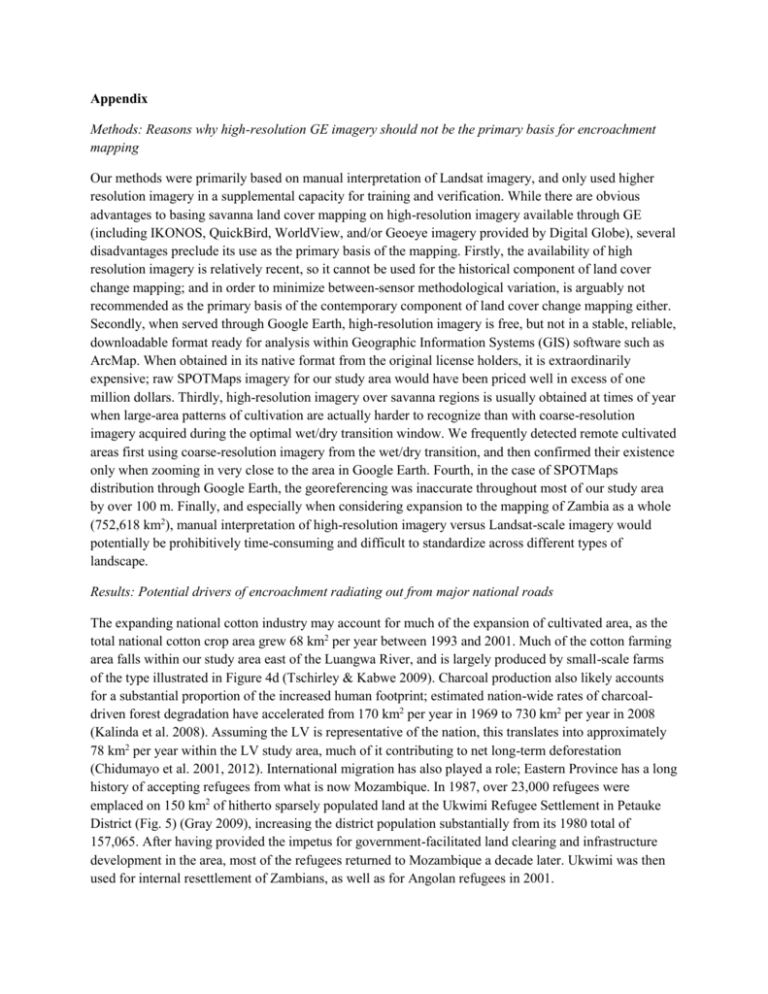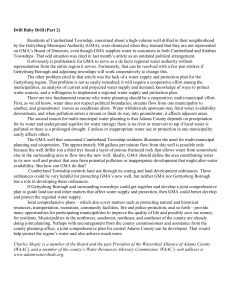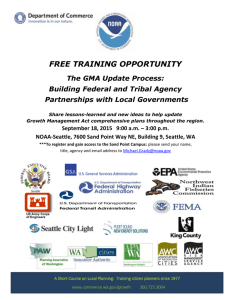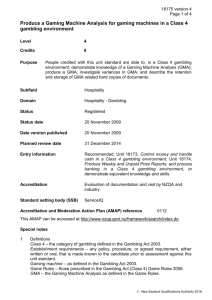Appendix - Springer Static Content Server
advertisement

Appendix Methods: Reasons why high-resolution GE imagery should not be the primary basis for encroachment mapping Our methods were primarily based on manual interpretation of Landsat imagery, and only used higher resolution imagery in a supplemental capacity for training and verification. While there are obvious advantages to basing savanna land cover mapping on high-resolution imagery available through GE (including IKONOS, QuickBird, WorldView, and/or Geoeye imagery provided by Digital Globe), several disadvantages preclude its use as the primary basis of the mapping. Firstly, the availability of high resolution imagery is relatively recent, so it cannot be used for the historical component of land cover change mapping; and in order to minimize between-sensor methodological variation, is arguably not recommended as the primary basis of the contemporary component of land cover change mapping either. Secondly, when served through Google Earth, high-resolution imagery is free, but not in a stable, reliable, downloadable format ready for analysis within Geographic Information Systems (GIS) software such as ArcMap. When obtained in its native format from the original license holders, it is extraordinarily expensive; raw SPOTMaps imagery for our study area would have been priced well in excess of one million dollars. Thirdly, high-resolution imagery over savanna regions is usually obtained at times of year when large-area patterns of cultivation are actually harder to recognize than with coarse-resolution imagery acquired during the optimal wet/dry transition window. We frequently detected remote cultivated areas first using coarse-resolution imagery from the wet/dry transition, and then confirmed their existence only when zooming in very close to the area in Google Earth. Fourth, in the case of SPOTMaps distribution through Google Earth, the georeferencing was inaccurate throughout most of our study area by over 100 m. Finally, and especially when considering expansion to the mapping of Zambia as a whole (752,618 km2), manual interpretation of high-resolution imagery versus Landsat-scale imagery would potentially be prohibitively time-consuming and difficult to standardize across different types of landscape. Results: Potential drivers of encroachment radiating out from major national roads The expanding national cotton industry may account for much of the expansion of cultivated area, as the total national cotton crop area grew 68 km2 per year between 1993 and 2001. Much of the cotton farming area falls within our study area east of the Luangwa River, and is largely produced by small-scale farms of the type illustrated in Figure 4d (Tschirley & Kabwe 2009). Charcoal production also likely accounts for a substantial proportion of the increased human footprint; estimated nation-wide rates of charcoaldriven forest degradation have accelerated from 170 km2 per year in 1969 to 730 km2 per year in 2008 (Kalinda et al. 2008). Assuming the LV is representative of the nation, this translates into approximately 78 km2 per year within the LV study area, much of it contributing to net long-term deforestation (Chidumayo et al. 2001, 2012). International migration has also played a role; Eastern Province has a long history of accepting refugees from what is now Mozambique. In 1987, over 23,000 refugees were emplaced on 150 km2 of hitherto sparsely populated land at the Ukwimi Refugee Settlement in Petauke District (Fig. 5) (Gray 2009), increasing the district population substantially from its 1980 total of 157,065. After having provided the impetus for government-facilitated land clearing and infrastructure development in the area, most of the refugees returned to Mozambique a decade later. Ukwimi was then used for internal resettlement of Zambians, as well as for Angolan refugees in 2001. Results: Potential explanations for contraction of the human footprint in remote areas In West Petauke GMA, four areas of 1960s settlement mapped by Schultz (1976) were apparently abandoned by 1985 and have never re-appeared (Figure 5a). They existed in the still very isolated territory of the Ambo tribe along the lower reaches of the Lukusashi River but well upstream of its confluence with the Luangwa near the Great East Road (Brelsford 1965). At least as recently as the 1950s, the Ambo frequently shifted villages when soil fertility became depleted and huts decayed, and they occasionally abandoned areas altogether after a spate of deaths or a ‘vision’ of being happier elsewhere (Stefaniszyn 1964). Much of the Ambo territory is beyond the boundary of our study area, so village shifting and abandonment for areas to the west could lead to reduction in the total mapped human footprint without implying a reduction in human population. The area is only accessible only by two rough roads descending the Muchinga Escarpment from the west and northwest, suggesting its continued isolation from the expansive forces of the developing world. However, formerly isolated cultivated areas upstream along the Lukusashi have merged into a continuously inhabited strip since 1985, suggesting that any long-abandoned floodplains in the area may yet be re-incorporated into the actively worked Ambo territory. A similar history of contraction and expansion in cultivated area is apparent in the Munyamadzi GMA, where we estimated the human-impacted area to have shrunk by 12 km2 (0.46%) per year before 1985, and then increased by 5 km2 (0.17%) per year after 1985. As with the Ambo in lower LV (i.e. the Lukusashi tributary), the Valley Bisa in the Munyamadzi GMA of the central LV were known to frequently shift villages for reasons including flooding and alleged sorcery (Marks 2005); but this does not necessary explain a reduction in total mapped cultivated area. Drought occurred in the area between 1983 and 1988 (Marks 2005), possibly explaining apparent reductions in human impact as simply temporary reductions in cultivated area without any fundamental change in employment, population size, or population distribution. But employment and population changes probably also played a role. In the 1970s, the national economy worsened, poaching dramatically increased, and the area became a source of bushmeat to the Great North Road region (Gibson 1995, Marks 2005). The bushmeat industry is an attractive alternative to farming (Brown & Marks 2007), and one that could lead to local reduction in cultivated area. Larger-scale population changes probably also played a role. Substantial migration from rural to urban areas took place after independence in 1964, particularly as far as the nearest railway line (Mwanza 1979; Hedlund and Lundahl 1983). The Tanzania-Zambia Railway was completed in 1974, parallel to the Great North Road and passing within about 40 km of the settlements in Munyamadzi GMA, so out-migration from Munyamadzi to the Great North Road probably occurred around this time, driven by expectation of higher income and better living conditions. Urbanization rates stabilized and even reversed in the 1980s (Ogura 1991; Simatele 2007; Potts 2009), which may partly explain the reversal in the decline in cultivated area in Munyamadzi GMA after 1985. GKE and KAZA TFCA As with LV, encroachment in the GKE has been rapid and extensive in some areas, and stable in others. A broad accelerating swath of encroachment has extended toward KNP from a major national road (the Lusaka-Livingstone Road) and railway since the 1960s. The only barriers to this encroachment have been the national park boundary, and the non-cultivatable wetlands of Kafue Flats between Bilili and Namwala GMAs. GMA boundaries have apparently had no effect on encroachment, to the extent that Bilili GMA is now 99% impacted, Namwala GMA is 84% impacted, and Mumbwa GMA is 54% impacted (Table 1). The originally intended ability of Bilili and Namwala GMAs to function as buffer zones to the national park has been essentially eliminated, and Mumbwa GMA is on a similar trajectory. The corridor between KNP and the rest of KAZA TFCA (in Namibia, Botswana, and Zimbabwe) has experienced substantial encroachment, but also positive steps toward wildlife protection. The corridor includes Sichifulo GMA, parts of Mulobezi GMA, some forest reserves, and the newly declared Simalaha Conservancy (Fig 5c.). A GMP for Sichifulo was approved in 2011, designating much of the GMA as a conservation zone. Parts of this conservation zone have been encroached, but this was offset to some extent by government-led removal of illegal settlers and a ministerial warning of the potential for being eliminated as a functioning GMA (Namugala 2009, Republic of Zambia 2011). To the west of KNP in Western Province, some settlements have disappeared since the 1960s, others have a relatively stable human footprint, and others have merged at a relatively manageable rate along watercourses (Fig 5c). The pattern is exemplified by the Nyambi area within Mufunta GMA, immediately west of the national park. Here, there is a stable or reducing human footprint, and a documented circumstance of human migration away from remote, poorly served areas toward a major road (the M9) to the north of the study area (Scott 2002). The Mulobezi GMA spans the interface of the two patterns, with remote and stable communities just to its north, but rapid encroachment from the south, near the terminus of the Mulobezi Railway line that extends northwest from Livingstone. Results: Buffer zones without a GMA designation Areas currently acting as buffer zones around national parks but without a GMA designation could experience a wide range of fates. They are exemplified by the Mupamadzi River headwaters, and the Kafue-KAZA corridor. The Mupamadzi River headwaters lie northwest of SLNP in a region that for many years was largely free of human impact (save for an isolated settlement at Kamwendo) but that is now subject to a substantial wave of encroachment emanating from the Great North Road (Fig. 5a). The portions immediately on the SLNP boundary are on the steep Muchinga Escarpment, while the portions between the escarpment and the Great North Road have been designated as the Mupamadzi Farm Block and subdivided for large-scale private farming (Department of Agriculture and TAZCORR Services 2010). In the absence of guidelines on the type of land use for the farms, there is a risk of destruction of rare large undisturbed tracts of miombo woodland. These wood lands are an important source of annual recharge to the Luangwa river system and an important ecological corridor spanning the Great North Road between SLNP and the Lavushi Manda National Park (not shown in Fig 5). The privately managed Mutinondo Wilderness lies in the center of this area, anchoring what is now a relatively undeveloped landscape Additional references Brelsford WV (1965) The tribes of Zambia. Government Printers, Lusaka. Brown T, Marks S (2007) Livelihoods, hunting and the game meat trade in northern Zambia. In Bushmeat and Livelihoods (eds Davies G, Brown D), Blackwell, Oxford, pp 92–106. Chidumayo E, Masialeti I, Ntalasha H, Kalumiana OS (2001) CHAPOSA - Charcoal Potential in Southern Africa: Final report for Zambia. European Union, International Cooperation with Developing Countries (INCO-DC). University of Zambia, Lusaka, 45 pp. Chidumayo EN, Gumbo DJ (2012) The environmental impacts of charcoal production in tropical ecosystems of the world: a synthesis. Energy for Sustainable Devel, 17:86-94. Gibson CC (1995) Killing Animals with Guns and Ballots: The Political Economy of Zambian Wildlife Policy. Environ Hist Rev, 19:49-75. Gray A (2009) Emplacing Displacement: Cultural Landscapes of Refugee-hosting in Ukwimi, Zambia. PhD dissertation, University of Kansas, 278 pp. Marks SA (2005) Large mammals and a brave people: Subsistence hunters in Zambia. With a new introduction and afterword by the author. Transaction Publishers, New Brunswick, USA. Mwanza JM (1979) Rural-urban migration and urban employment in Zambia. The Developing Economies, 17:172-181. Ogura M (1991) Rural-urban migration in Zambia and migrant ties to home villages. The Developing Economies, 29:145-165. Potts, D. 2009. The slowing of sub-Saharan Africa's urbanization: evidence and implications for urban livelihoods. Environ and Urbanization, 21:253-259. Republic of Zambia (2011) Sixth national development plan 2011–2015, 235 pp Scott G (2002) Zambia: structural adjustment, rural livelihoods and sustainable development. Development Southern Africa, 19(3):405-418. Simatele D (2007) Kwacha ngwee: a snapshot at Zambia’s contemporary migration patterns. Paper presented at the African Migrations workshop, Accra, Ghana. 18th-21st September 2007. Stefaniszyn B (1964) The material culture of the Ambo of Northern Rhodesia. No. 16. RhodesLivingstone Museum.







